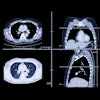
Traditional radiation dose measurements are grossly inaccurate for perfusion CT head scans, which are being performed with increasing frequency for patients with suspected stroke, according to a study presented on July 22 at the American Association of Physicists in Medicine (AAPM) meeting in Philadelphia.
Researchers found that standard patient dose reports overestimate the skin dose for perfusion CT head scans by as much as 50% to 75%, while underestimating other doses by as much as 20%. Dose measurements for body perfusion scans were generally more accurate, said the researchers from M. D. Anderson Cancer Center at the University of Texas in Houston.
Study authors John Rong, PhD, and Dianna Cody, PhD, concluded that scanner-generated CT dose index volume (CTDIvol) dose reports, which are based on algorithms developed in phantom studies using the conventional CTDI100 method, are inadequate for perfusion CT.
Beyond the AAPM presentation, wide differences in reported doses are known to affect a growing list of applications, including vascular interventional procedures, conebeam CT body and dental studies, and radiation therapy treatment planning applications, said Cody in a telephone interview with AuntMinnie.com. "Under most conditions of CT, the older method works just fine," she said.
But in an era where patient radiation doses are subject to intense scrutiny, the inaccuracies in perfusion CT dosimetry suggest a liability that will need to be addressed sooner rather than later.
Cody said the study focused on the head and body CT doses that are a key concern at M. D. Anderson.
"We looked at CT perfusion of the head, and CT perfusion of the body, which isn't done nearly as often, but it's done at our institution because we look at tumors, so we were really looking at the perfusion case and not so much the conebeam CT case," she said.
The Farmer chamber design used in the study was developed early in the decade by Robert Dixon, PhD, from Wake Forest University School of Medicine in Winston-Salem, NC, Cody said. The devices feature shorter ionization chambers compared to those of traditional pencil-beam dosimeters, which differ from Farmer chambers mainly in the length of the ionization chamber.
Short-chamber designs are achieving wider clinical use in some applications, becoming quite common in radiation therapy planning applications, she said. But day-to-day CT scanning still relies on traditional CTDI-based reports developed with the use of conventional longer-ionization-chamber dosimeters.
The M. D. Anderson study is among the first to validate the short-chamber devices for common exams such as perfusion CT for stroke assessment, and perfusion body scanning, Cody said. The researchers scanned both head and body phantoms made of tissue-equivalent materials.
Using a Farmer chamber, they measured point doses under various scan conditions on the surface of anthropomorphic phantoms, as well as at the top-hole position of acrylic CTDI phantoms on two 64-detector-row CT scanners including a LightSpeed VCT (GE Healthcare, Chalfont St. Giles, U.K.) and a Somatom Sensation 64 (Siemens Healthcare, Malvern, PA).
Also at the top-hole position of CTDI head and body phantoms, the researchers measured CTDI100 values using a 100-mm pencil ion chamber, normalizing the pitch factors. They also tested the dosimeters in two sizes of CTDI phantoms (head) and anthropomorphic phantoms (body) constructed of tissue-equivalent materials.
Each phantom was scanned alternately using the nanoDot device, the Farmer device, and a traditional pencil chamber dosimetry device to see how well the new devices matched each other and, in turn, how they compared with the pencil chamber device, Cody said.
"We ran these three point dosimeters plus the older pencil-style chambers as well, and showed how much error the older-style chamber approach causes," Cody said.
The group calculated the ratio of CTDI100 (top)/pitch over the point dose under each scan condition and evaluated the results to determine if the CTDI method underestimated or overestimated skin dose. The nanoDots were calibrated using the same kVp as the CT scans, and calibration was conducted separately for each scanner, Cody said.
 |
 |
According to the results, the CTDI100 approach overestimated skin dose by 50% to 75% for head cine (perfusion CT) scans, the authors reported. Most body measurements were within 10%.
 |
| CTDI100 is the conventional method of measuring skin radiation exposure in CT, and the "Farmer chamber" ("Dixon method") is the newer approach. Above, phantom results of head CT perfusion (cine head) scans of the type used to evaluate suspected stroke show wide and highly variable differences between Farmer chamber and pencil chamber results, which varied based on scanner type and body size. Below, phantom results for body perfusion scans were generally less variable. All images courtesy of Dianna Cody, PhD. |
 |
The magnitude of the CTDI errors depended on the size and shape of phantoms, as well as the scanners used for the body cine scans, the team reported.
The Farmer chamber and nanoDot readings generally agreed with each other well -- in most cases within 10%. But while the similarity of the short-chamber and nanoDot results were encouraging, the range of dose measurements shown by the pencil chamber was wide and "kind of scary because it wasn't predictable," Cody told AuntMinnie.com.
"I had expected there to be a predictable amount of error, maybe in the 50% to 100% range, and it wasn't that at all," she said. "Some results were overestimated, some were underestimated, and it wasn't at all predictable."
Using Farmer chamber and nanoDot techniques for skin dose CT dosimetry is clinically practical and should be used for perfusion scans, the authors concluded. Appropriately calibrated nanoDots can be used to monitor patient skin dose during a clinical CT exam without causing image artifacts, they said.
By Eric Barnes
AuntMinnie.com staff writer
July 27, 2010
Related Reading
Conebeam reconstruction method speeds processing, cuts dose, July 21, 2010
Mayo method enables perfusion CT in a fraction of the dose, July 20, 2010
Court transcripts don't resolve questions in Mad River CT case, July 1, 2010
CT speeds antiangiogenesis therapy assessment, June 14, 2010
Perfusion CT handily distinguishes malignant neck nodes, January 25, 2010
Copyright © 2010 AuntMinnie.com




















